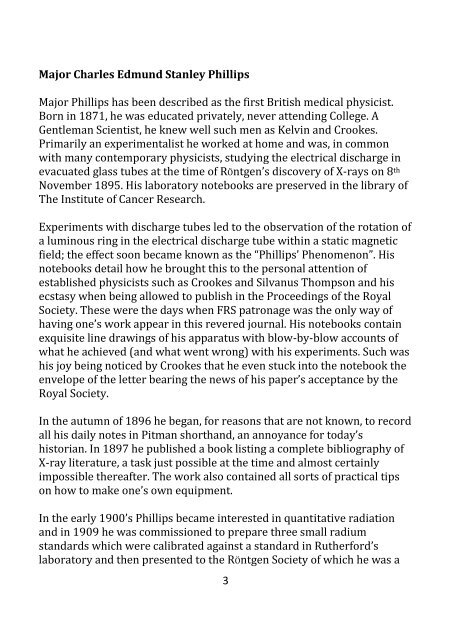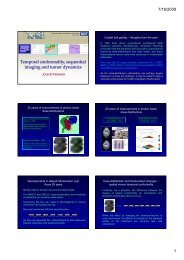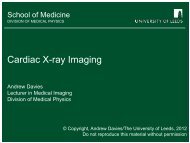here - The Mayneord Phillips Trust
here - The Mayneord Phillips Trust
here - The Mayneord Phillips Trust
You also want an ePaper? Increase the reach of your titles
YUMPU automatically turns print PDFs into web optimized ePapers that Google loves.
Major Charles Edmund Stanley <strong>Phillips</strong>Major <strong>Phillips</strong> has been described as the first British medical physicist.Born in 1871, he was educated privately, never attending College. AGentleman Scientist, he knew well such men as Kelvin and Crookes.Primarily an experimentalist he worked at home and was, in commonwith many contemporary physicists, studying the electrical discharge inevacuated glass tubes at the time of RÖntgen’s discovery of X-rays on 8 thNovember 1895. His laboratory notebooks are preserved in the library of<strong>The</strong> Institute of Cancer Research.Experiments with discharge tubes led to the observation of the rotation ofa luminous ring in the electrical discharge tube within a static magneticfield; the effect soon became known as the “<strong>Phillips</strong>’ Phenomenon”. Hisnotebooks detail how he brought this to the personal attention ofestablished physicists such as Crookes and Silvanus Thompson and hisecstasy when being allowed to publish in the Proceedings of the RoyalSociety. <strong>The</strong>se were the days when FRS patronage was the only way ofhaving one’s work appear in this revered journal. His notebooks containexquisite line drawings of his apparatus with blow-by-blow accounts ofwhat he achieved (and what went wrong) with his experiments. Such washis joy being noticed by Crookes that he even stuck into the notebook theenvelope of the letter bearing the news of his paper’s acceptance by theRoyal Society.In the autumn of 1896 he began, for reasons that are not known, to recordall his daily notes in Pitman shorthand, an annoyance for today’shistorian. In 1897 he published a book listing a complete bibliography ofX-ray literature, a task just possible at the time and almost certainlyimpossible t<strong>here</strong>after. <strong>The</strong> work also contained all sorts of practical tipson how to make one’s own equipment.In the early 1900’s <strong>Phillips</strong> became interested in quantitative radiationand in 1909 he was commissioned to prepare three small radiumstandards which were calibrated against a standard in Rutherford’slaboratory and then presented to the RÖntgen Society of which he was a3





